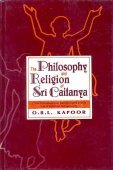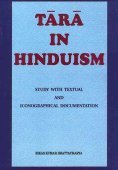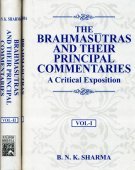Vaishnavism, Vaiṣṇavism: 7 definitions
Introduction:
Vaishnavism means something in Hinduism, Sanskrit, the history of ancient India. If you want to know the exact meaning, history, etymology or English translation of this term then check out the descriptions on this page. Add your comment or reference to a book if you want to contribute to this summary article.
In Hinduism
Vaishnavism (Vaishava dharma)
Source: Acta Orientalia vol. 74 (2013): Historical sequence of the Vaiṣṇava DivyadeśasVaiṣṇavism (वैष्णविस्म्) (Viṣṇuism) takes its root in Vedic lore and reaches a saturation level in the hymns of the Āḻvars. Here Viṣṇu is the focal point of attention. Śrīvaiṣṇavism/Śrīviṣṇuism developed as a codified system of philosophy after the time of Rāmānuja in the 12th century. Here the focal point is Viṣṇu through the mediator Śrī. Viṣṇuism is a religion and Śrīvaiṣṇavism a philosophical way of approach to Viṣṇuism.

Vaishnava (वैष्णव, vaiṣṇava) or vaishnavism (vaiṣṇavism) represents a tradition of Hinduism worshipping Vishnu as the supreme Lord. Similar to the Shaktism and Shaivism traditions, Vaishnavism also developed as an individual movement, famous for its exposition of the dashavatara (‘ten avatars of Vishnu’).
Vedanta (school of philosophy)
Source: Shodhganga: Siva Gita A Critical StudyVaishnavism (Vaiṣṇavism) refers to one of the four major religions or denominations of Hinduism, representing roughly half of the world’s one billion Hindus. It gravitates around the worship of Lord Viṣṇu as Personal God, His incarnations and their consorts. Vaiṣṇavism stresses the personal aspect of God over the impersonal, and bhakti (devotion) as the true path to salvation.

Vedanta (वेदान्त, vedānta) refers to a school of orthodox Hindu philosophy (astika), drawing its subject-matter from the Upanishads. There are a number of sub-schools of Vedanta, however all of them expound on the basic teaching of the ultimate reality (brahman) and liberation (moksha) of the individual soul (atman).
General definition (in Hinduism)
Source: WikiPedia: HinduismVaishnavism (वैष्णव धर्म): Vaishnavism is a tradition of Hinduism, distinguished from other schools by its worship of Vishnu or his associated avatars, principally as Rama and Krishna, as the original and supreme God.
India history and geography
Source: archive.org: Social Life In Medieval RajasthanVaiṣṇavism in Rājasthān.—After the 15th century, the cult of Brahmā seems to have merged in that of Śiva, Viṣṇu or Sun—a conception of Tripuruśa. This is evidenced by the images of Bhāwal (Medtā), Rāṇpur (Mārwār) and Rāmgarh (Kotāh) in which these deities have been combined with that of Brahmā on account of the growing influence of Śaivism and Vaiṣṇavism.
Source: archive.org: Nilamata Purana: a cultural and literary study (history)Vaiṣṇavism (वैष्णविस्म्) refers to one of the religious institutions once common in ancient Kashmir (Kaśmīra) as mentioned in the Nīlamatapurāṇa.—Vaiṣṇavism occupies an important place in the Nīlamata which speaks of Viṣṇu more than of any other deity.
Source: What is India: Inscriptions of the ŚilāhārasVaiṣṇavism during the reign of the Śilāhāra dynasty (r. 765-1215 A.D.).—Viṣṇu was another popular deity, but Śilāhāra records contain very few references to grants made in his honour. There was a temple of Lakṣmī-Nārāyaṇa at Māṇḍavalī (modern Māṇḍavī in the Ṭhāṇā District), to which a grant was made in the reign of Keśideva II.
Source: Shodhganga: Vaisnavism in Andhradesa A D 1000 to 1600 A historical studyVaiṣṇavism during the rule of the Haihayas (A.D. 1100-1200).—In the Palnāḍ region (Guntur Dt.) Vaiṣṇavism gained firm ground during the rule of the Haihayas. The focal centre of Vaiṣṇavism in this region was the Chennakeśava temple at Mācerla. The Palnāṭi-vīracaritra describes how the ūrināyakulu (leaders of the village), kāpus and other lowers sections of the śūdra caste and the pañcamas adopted Vaiṣṇavism and stood behind Brahmanāyuḍu in all his social reforms, consistent with the spirit of Śrīvaiṣṇavism.

The history of India traces the identification of countries, villages, towns and other regions of India, as well as mythology, zoology, royal dynasties, rulers, tribes, local festivities and traditions and regional languages. Ancient India enjoyed religious freedom and encourages the path of Dharma, a concept common to Buddhism, Hinduism, and Jainism.
See also (Relevant definitions)
Query error!
Full-text (+1319): Kanci, Mamallapuram, Ayintai, Tuvarai, Tuvarakai, Vaishnavan, Arunagiri, Vaikuntam, Nayanar, Divyasthala, Shaivism, Kancipura, Pantinatu, Ceranatu, Alvar, Tattvagunadarsha, Madhusudanasarasvati, Hari, Natunatu, Ramanuja.
Relevant text
Search found 102 books and stories containing Vaishnavism, Vaiṣṇavism, Vaisnavism; (plurals include: Vaishnavisms, Vaiṣṇavisms, Vaisnavisms). You can also click to the full overview containing English textual excerpts. Below are direct links for the most relevant articles:
Sucindrasthala-mahatmya (critical edition and study) (by Anand Dilip Raj)
Vaishnavism in the Sucindrasthalamahatmya < [Chapter 4 - Sucindrasthalamahatmya: a critical study]
Shaivism in the Sucindrasthalamahatmya < [Chapter 4 - Sucindrasthalamahatmya: a critical study]
Puranic legends: Story of Indra and Ahalya < [Chapter 4 - Sucindrasthalamahatmya: a critical study]
The concept of Yoga according to Yoga Upanisads (by Jeong Soo Lee)
3a. Bhakti-Yoga in Vaishnavism < [Chapter 2 - The nature of Karma, Jnana and Bhakti as the kinds of Yoga]
3b. Bhakti-Yoga in Shaivism < [Chapter 2 - The nature of Karma, Jnana and Bhakti as the kinds of Yoga]
6. Yogic Concepts in the Mahabharata and Puranas < [Chapter 1 - The Origin of Yoga and its Evolution]
Shaivacintamani (analytical study) (by Swati Sucharita Pattanaik)
Part 4 - Śaivism in South Kosala < [Chapter 1: Introduction to Śaivism]
Part 2 - The Origin and Development of Śaivism in Orissa (Odisha) < [Chapter 1: Introduction to Śaivism]
Part 6 - Introduction to Tantric Śaivism < [Chapter 1: Introduction to Śaivism]
Yasastilaka and Indian culture (Study) (by Krishna Kanta Jandiqui)
Chapter 13h - Jainism and Vaishnavism
Appendix 3e - Shaiva temples at Orissa (Odisha)
Lakulisha-Pashupata (Philosophy and Practice) (by Geetika Kaw Kher)
Overall Structure and Methodological considerations < [Introduction]
Early Textual References < [Chapter 1 - The Historical Context]
Book Reviews < [October – December 1991]
Bhaavas in Vaishnavism and Saivism: A Comparative Study < [October – December, 1981]
Chaitanya's First Vision < [January-February, 1929]
Related products



